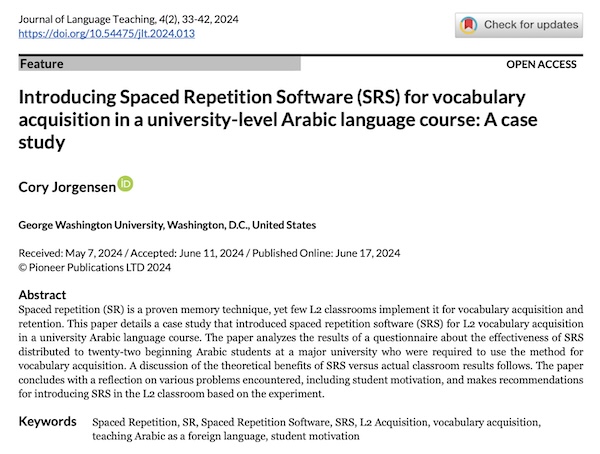Introducing Spaced Repetition Software (SRS) for vocabulary acquisition in a university-level Arabic language course: A case study
DOI:
https://doi.org/10.54475/jlt.2024.013Keywords:
Spaced Repetition, SR, Spaced Repetition Software, SRS, L2 acquisition, vocabulary acquisition, teaching Arabic as a foreign language, student motivationAbstract
Spaced repetition (SR) is a proven memory technique, yet few L2 classrooms implement it for vocabulary acquisition and retention. This paper details a case study that introduced spaced repetition software (SRS) for L2 vocabulary acquisition in a university Arabic language course. The paper analyzes the results of a questionnaire about the effectiveness of SRS distributed to twenty-two beginning Arabic students at a major university who were required to use the method for vocabulary acquisition. A discussion of the theoretical benefits of SRS versus actual classroom results follows. The paper concludes with a reflection on various problems encountered, including student motivation, and makes recommendations for introducing SRS in the L2 classroom based on the experiment.
References
Abrams, S. S., & Walsh, S. (2014). Gamified vocabulary: Online resources and enriched language learning. Journal of Adolescent & Adult Literacy, 58(1), 49-58. DOI: https://doi.org/10.1002/jaal.315
Allwright, D. (2005). Developing principles for practitioner research: The case of exploratory practice. The Modern Language Journal, 89(3), 353-366. https://doi.org/10.1111/j.1540-4781.2005.00310.x DOI: https://doi.org/10.1111/j.1540-4781.2005.00310.x
Barcroft, J. (2009). Strategies and performance in intentional L2 vocabulary learning. Language Awareness, 18(1), 74-89. https://doi.org/10.1080/09658410802557535 DOI: https://doi.org/10.1080/09658410802557535
Bower, J. V., & Rutson-Griffiths, A. (2016). The relationship between the use of spaced repetition software with a TOEIC word list and TOEIC score gains. Computer Assisted Language Learning, 29(7), 1238-1248. https://doi.org/10.1080/09588221.2016.1222444 DOI: https://doi.org/10.1080/09588221.2016.1222444
Cain, L. F., & Willey, R. D. V. (1939). The effect of spaced learning on the curve of retention. Journal of Experimental Psychology, 25(2), 209-214. https://doi.org/10.1037/h0054640 DOI: https://doi.org/10.1037/h0054640
Castañeda, D. A., & Cho, M.-H. (2016). Use of a game-like application on a mobile device to improve accuracy in conjugating Spanish verbs. Computer Assisted Language Learning, 29(7), 1195-1204. https://doi.org/10.1080/09588221.2016.1197950 DOI: https://doi.org/10.1080/09588221.2016.1197950
Cepeda, N. J., Pashler, H., Vul, E., Wixted, J. T., & Rohrer, D. (2006). Distributed practice in verbal recall tasks: A review and quantitative synthesis. Psychological Bulletin, 132(3), 354-380. https://doi.org/10.1037/0033-2909.132.3.354 DOI: https://doi.org/10.1037/0033-2909.132.3.354
Coady, J., & Huckin, T. N. (1997). Second language vocabulary acquisition: A rationale for pedagogy. Cambridge University Press. DOI: https://doi.org/10.1017/CBO9781139524643
Colman, A. M. (2015). Josts’s law. In A dictionary of psychology.
Deci, E. L., & Ryan, R. M. (1985). Intrinsic motivation and self-determination in human behavior. Plenum. DOI: https://doi.org/10.1007/978-1-4899-2271-7
Dempster, F. N. (1988). The spacing effect: A case study in the failure to apply the results of psychological research. American Psychologist, 43(8), 627-634. https://doi.org/10.1037/0003-066X.43.8.627 DOI: https://doi.org/10.1037//0003-066X.43.8.627
Dörnyei, Z. (1994). Motivation and motivating in the foreign language classroom. The Modern Language Journal, 78(3), 273-284. https://doi.org/10.2307/330107 DOI: https://doi.org/10.1111/j.1540-4781.1994.tb02042.x
Ebbinghaus, H. (1885). Über das gedächtnis: untersuchungen zur experimentellen psychologie. Duncker & Humblot.
Gardner, R. C., & Lambert, W. E. (1972). Attitudes and motivation in second-language learning. Newbury House Publishers.
Hanson‐Smith, E. (2016). Games, gaming, and gamification: Some aspects of motivation. TESOL Journal, 7(1), 227-232. DOI: https://doi.org/10.1002/tesj.233
Hintzman, D. L. (1974). Theoretical implications of the spacing effect. In Theories in cognitive psychology: The Loyola Symposium. (pp. 77-99). Lawrence Erlbaum.
Krashen, S. (1982). Principles and practice in second language acquisition. Pergamon. DOI: https://doi.org/10.1111/j.1467-971X.1982.tb00476.x
Levy, M., & Steel, C. H. (2013). Language students and their technologies: Charting the evolution 2006–2011. ReCALL, 25(3), 306-320. https://doi.org/10.1017/S0958344013000128 DOI: https://doi.org/10.1017/S0958344013000128
Melton, A. W. (1970). The situation with respect to the spacing of repetitions and memory. Journal of Verbal Learning and Verbal Behavior, 9(5), 596-606. https://doi.org/10.1016/S0022-5371(70)80107-4 DOI: https://doi.org/10.1016/S0022-5371(70)80107-4
Nakata, T. (2011). Computer-assisted second language vocabulary learning in a paired-associate paradigm: a critical investigation of flashcard software. Computer Assisted Language Learning, 24(1), 17-38. https://doi.org/10.1080/09588221.2010.520675 DOI: https://doi.org/10.1080/09588221.2010.520675
Schmitt, N. (2008). Review article: Instructed second language vocabulary learning. Language teaching research, 12(3), 329-363. https://doi.org/10.1177/1362168808089921 DOI: https://doi.org/10.1177/1362168808089921
Spitzer, H. F. (1939). Studies in retention. Journal of Educational Psychology, 30(9), 641-656. https://doi.org/10.1037/h0063404 DOI: https://doi.org/10.1037/h0063404
Teninbaum, G. H. (2017). Spaced repetition: A method for learning more law in less time. Journal of High Technology Law, 17(2), 273-312.
Underwood, B. J. (1970). A breakdown of the total-time law in free-recall learning. Journal of Verbal Learning and Verbal Behavior, 9(5), 573-580. https://doi.org/10.1016/S0022-5371(70)80104-9 DOI: https://doi.org/10.1016/S0022-5371(70)80104-9
Von Wright, J. (1971). Effects of distributed practice and distributed recall tests on later recall of paired associates. Journal of Verbal Learning and Verbal Behavior, 10(3), 311-315. DOI: https://doi.org/10.1016/S0022-5371(71)80060-9
Wozniak, P. (2018). The true history of spaced repetition. Retrieved January 1 from https://www.supermemo.com/en/blog/the-true-history-of-spaced-repetition

Downloads
Published
Issue
Section
License
Copyright (c) 2024 Journal of Language Teaching

This work is licensed under a Creative Commons Attribution 4.0 International License.




